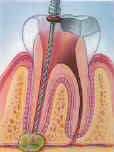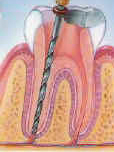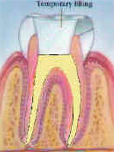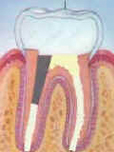Root Canal Therapy Before & After Surgery
Click here to download our Root Canal Therapy pdf.
 | Step 1: An abscess has formed at the tip of the tooth’s root. An opening is made into the tooth, and the decay is removed to expose the pulpal tissue (the tooth’s soft core, your tooth’s nerve center) and allow access to the diseased pulp and infection. |
 | Step 2: The canals are cleaned and shaped with very fine metal files. This may be completed in a single visit or require several visits depending on the health of the tooth and the access to the tip of the root. |
 | Step 3: The canals are cleaned out and a temporary filling may be placed to protect the tooth between appointments. The pulp chamber and root canal is permanently filled and sealed to prevent bacteria from entering. Occasionally a metal pin (called a post) is also inserted into the canal to help restore the tooth. |
 | Step 4: The missing tooth structure is replaced with a filling and the tooth is returned to function with a crown to restore the tooth to its natural structure and appearance in hopes of preventing fracture. |
Copyright: www.dentalgentlecare.com
Root canal treatment is performed in an attempt to save a tooth that might otherwise need to be removed. It is necessary when the pulp of the tooth becomes infected or injured. The pulp, located in the interior structure of a tooth, houses the nerves and blood vessels of the tooth. It extends from the crown of the tooth down through one or more root canals, to the end of the root.
Conventional root canal treatment has a success rate in the range of 70 – 90%. In the percentage of root canal treatments that fail, the primary reason is inoperable anatomy in the roots. This can result in an incomplete seal of the canal and subsequent infection. Others fail due to an ongoing infection around the root (requiring an apicoectomy) or small fractures in the root (requiring extraction). An unsuccessful root canal does not necessarily indicate the treatment was performed improperly.
After your treatment you can expect mild to moderate discomfort. This discomfort is due to inflammation around the root of the tooth and is a normal part of the healing process. The symptoms will usually be a dull ache and sensitivity to chewing, biting, or touch, which may intensify during the first 3-4 days after treatment but should gradually decrease soon after. The symptoms can be minimized by taking an antiinflammatory medication soon after completion of the root canal treatment. The key is to take the medication regularly, as prescribed. Pain medication will probably be necessary and can be taken as needed. Your bite may feel “off” for a few days, but should return to normal after the inflammation subsides.
If you have a tendency to grind your teeth habitually, the duration and degree of the discomfort may be intensified and last longer as the inflammation does not have an opportunity to subside due to the constant trauma on the tooth. Should the discomfort continue to intensify after one week, or not subside, it is important to call our office so further evaluation can be done. Complications of treatment include, but are not limited to the following:
- Irretrievable broken instruments in the canal
- Inaccessible canals
- Fracture of the root
- Infection or chronic irritation of the bone
- Damage to existing restorations
- Non-healing lesions in the bone around the end of the tooth
- Perforation of canal walls
- Loss of existing tooth structure
It is important that teeth with root canal treatments have crowns placed upon them. Endodontically treated teeth are more prone to fracture than untreated teeth, and may also experience additional complications, including extraction and a higher risk of infection, if not sealed with a crown.
Should your symptoms continue or worsen, an apicoectomy, may be required. This is a surgical procedure in which the end of the root is sealed via a small opening in the gum and bone overlying the root tip.







